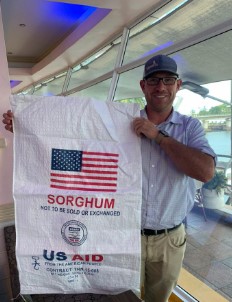More than 23 million people are food insecure in eastern and central Africa, with food security conditions worsening in Burundi, Somalia and South Sudan. A recent two-week food aid journey demonstrated firsthand to U.S. Grains Council (USGC) members and staff how U.S. sorghum is used in regional food aid and food assistance programs.
U.S. Wheat Associates organized the program, which included high-level representatives from sorghum, wheat and rice sectors. USA Rice Federation also participated in the mission, which visited the U.S. International Development Agency (USAID) and U.S. Department of Agriculture (USDA) funded programs in Kenya and Tanzania.
“This program sought to enhance understanding of the food aid and food assistance programs in East Africa,” said Katy Wyatt, USGC manager of global strategies. “Sorghum is a staple for these efforts as a key cereal crop in Africa, Central America and Asia.”
USAID Office of Food for Peace (FFP) works to reduce hunger and malnutrition globally – providing nearly 1.4 million metric tons in fiscal year 2018 of U.S. in-kind and locally/regionally procured commodities, in addition to cash transfers and food vouchers. USAID/FFP is the largest donor-to-food assistance program, providing more than $1.7 billion in fiscal year 2018, to meet both chronic and acute food needs globally. USAID/FFP is also a key donor to the World Food Programme (WFP) – the largest humanitarian organization addressing hunger, malnutrition and food security globally.
In fiscal year 2018, USAID/FFP provided more than 415,000 tons (16.3 million bushels) of U.S. sorghum globally. The program provided more than $35 million in cash-landed and in-kind food assistance, including more than 55,000 tons (2.17 million bushels) of U.S. sorghum, to assist refugees living in Kenya’s two refugee camps. So far in 2019, more than 12,000 tons (472,000 bushels) of U.S. sorghum has landed in Kenya for food aid use.

As part of their mission, the U.S. team visited the WFP Kakuma Refugee Camp in northwestern Kenya. The camp, established in 1992, is home to 145,000 registered refugees and asylum seekers from sub-Saharan Africa, including South Sudan, Ethiopia, Democratic Republic of the Congo and Burundi. U.S. food aid, including U.S. sorghum and wheat, is critical for this refugee camp as the USAID/FFP provides nearly 60 percent of the in-kind food aid needed. While at the camp, the team met with WFP staff as well as the camp’s Food Distributional Council – comprised of Kakuma refugees.
“I was really impressed with how the food aid and food assistance programs operate on the ground,” said Adam Schindler, a South Dakota sorghum farmer who serves on the United Sorghum Checkoff Program board and the Council’s Asia Advisory Team. “This educational experience demonstrated how U.S. commodities – like the sorghum I grow on my farm – are used in a responsible and effective manner.”
The delegation also visited the WFP regional warehouse at Kenya’s Port of Mombasa. At that time, a 36,000 ton-vessel (1.42 million bushels) of U.S. sorghum was en route to the port, half of which was destined for the WFP in Kenya, with the remainder headed to ports in Somalia and Sudan.
“We left the refugee camp hearing about the need for more sorghum and then traveled to the port, where a large vessel of U.S. sorghum was about to land,” Schindler. “It makes me very proud as a sorghum farmer to see how we are truly helping to feed the world.”
The mission also included meetings with USDA-led food assistance and development programs in both Kenya and Tanzania, including the McGovern-Dole International Food for Education and Child Nutrition Program. The McGovern-Dole Program works to reduce hunger and improve literary and primary education of children, especially girls, in lower-income countries. In Kenya, the program has provided more than one million school lunches to primary school children that include donated U.S. agricultural commodities like rice.
“Our trip to Kenya and Tanzania was incredibly educational as it effectively filled in gaps to help farmers and commodity group staff better understand food aid logistics and distribution,” said Linsey Ogden, who represented the National Sorghum Producers on the mission. “It is vital that U.S. stakeholders grasp the importance of the program and demonstrate that the U.S and its agricultural industry are not silent donors, but rather a vital sector of the value chain to address world hunger.”
The delegation also gained insight into USAID Feed the Future and USDA Food for Progress (USDA/FFP) projects, including some of the Council’s key beneficiaries in Tanzania. Under the USDA/FFP, USDA donates U.S. agricultural commodities to partners globally, who monetize the products by selling them on the local market, raising funds for agricultural and economic development projects. More than 190,000 tons of U.S. agricultural commodities funded nine programs in fiscal year 2018.
These projects demonstrate another way the U.S. agricultural sector is working to provide commodities to food-insecure or vulnerable countries. Additionally, through the USDA/FFP, the Council has provided technical trainings and other support to professionalize the local industry.
Click here to see more...